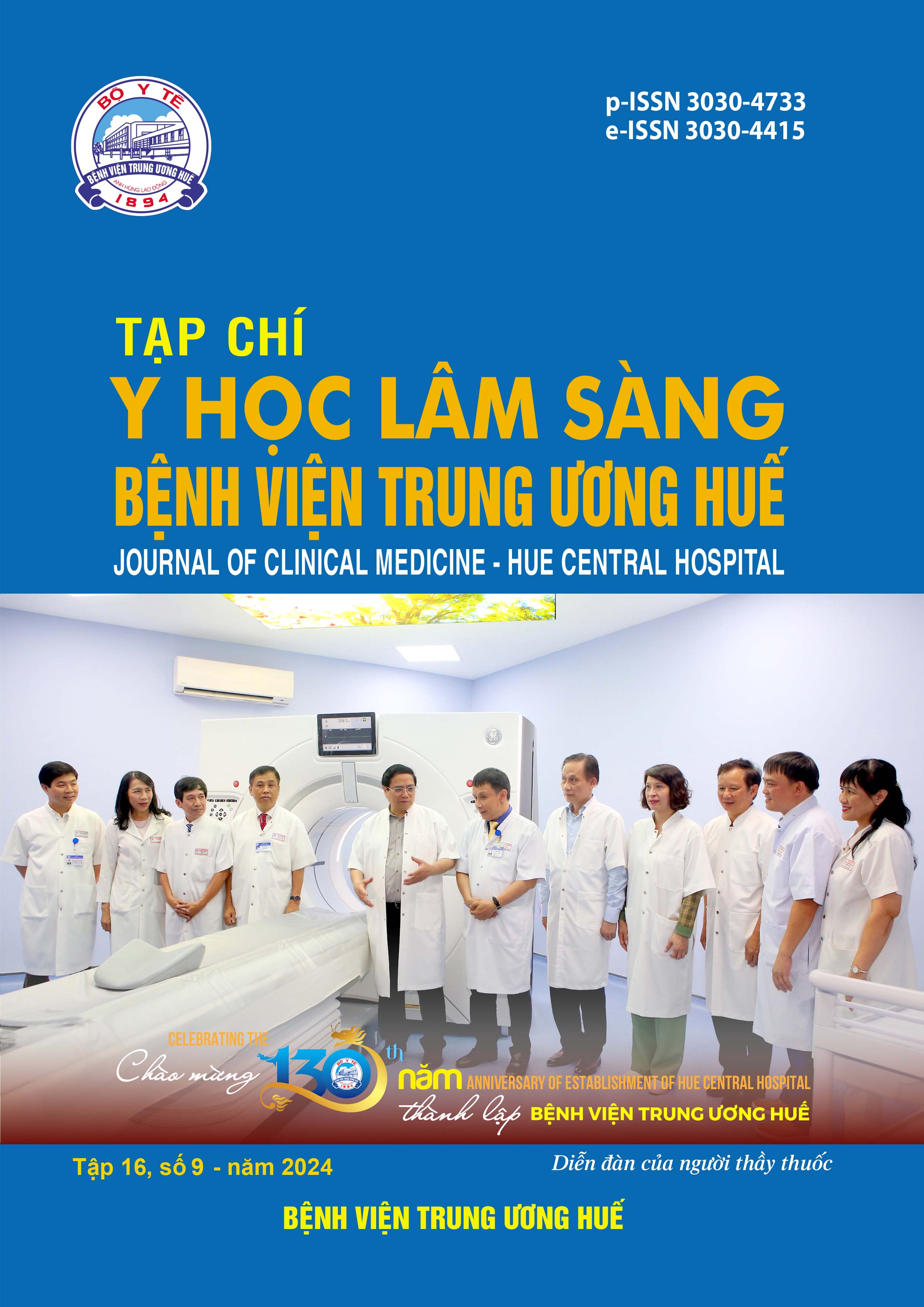Tóm tắt
Mục tiêu: Khảo sát độ phù hợp của Xquang cắt lớp vi tính (XQCLVT) ở bệnh nhân u mô đệm đường tiêu hóa (GISTs) với kết quả phẫu thuật và giải phẫu bệnh về vị trí và tính chất xâm lấn của u. Xác định mối liên hệ giữa các số đo hình dạng u trên XQCLVT và nguy cơ ác tính (NCAT) của u mô đệm đường tiêu hóa.
Đối tượng, phương pháp: Nghiên cứu hồi cứu, mô tả loạt ca. Từ tháng 01/2021 đến tháng 01/2024, hồi cứu 51 trường hợp được chụp XQCLVT và phẫu thuật tại bệnh viện Ung Bướu TP. HCM.
Kết quả: GISTs thường gặp ở dạ dày, ở bệnh nhân trên 50 tuổi. Kết quả XQCLVT phù hợp với kết quả giải phẫu bệnh sau mổ về vị trí, tình trạng xâm lấn của u. Có sự khác biệt có ý nghĩa thống kê giữa đường kính trục dài, đường kính trục ngắn, góc nhỏ, tỉ số góc lớn/góc nhỏ của u và NCAT của u phân loại theo 3 nhóm: nguy cơ rất thấp – thấp, nguy cơ trung bình, nguy cơ cao. Đường kính trục dài, trục ngắn và tỉ số góc lớn/ góc nhỏ có khả năng phân nhóm NCAT cao và các nhóm còn lại.
Kết luận: Xquang cắt lớp vi tính là phương pháp rất có giá trị trong chẩn đoán vị trí, tính chất xâm lấn của GISTs, các giá trị đường kính trục ngắn, đường kính trục dài, tỉ số góc lớn/ góc nhỏ có thể phân biệt u có NCAT cao và nhóm còn lại.
Tài liệu tham khảo
Chandrajit P Raut M, MSc, FACSAnette Duensing, MDVicki L Keedy, MD, MSCI. Clinical presentation, diagnosis, and prognosis of gastrointestinal stromal tumors. 2023 [cited 2023 9/7/2023]; Available from: https://www.uptodate.com/contents/clinical-presentation-diagnosis-and-prognosis-of-gastrointestinal-stromal-tumors#H2.
Rubin BP, Heinrich MC, and Corless CL. Gastrointestinal stromal tumour. Lancet. 2007; 369(9574): 1731-41.
Ma GL, Murphy JD, Martinez ME, and Sicklick JK. Epidemiology of gastrointestinal stromal tumors in the era of histology codes: results of a population-based study. Cancer Epidemiol Biomarkers Prev. 2015; 24(1): 298-302.
Demetri GD. NCCN Task Force report: update on the management of patients with gastrointestinal stromal tumors. J Natl Compr Canc Netw. 2010; 8 Suppl 2(0 2): S1-41; quiz S42-4.
von Mehren M, et al. NCCN Guidelines® Insights: Gastrointestinal Stromal Tumors, Version 2.2022: Featured Updates to the NCCN Guidelines. Journal of the National Comprehensive Cancer Network. 2022; 20(11): 1204-1214.
Casali PG. Gastrointestinal stromal tumours: ESMO-EURACAN-GENTURIS Clinical Practice Guidelines for diagnosis, treatment and follow-up. Ann Oncol. 2022; 33(1): 20-33.
Kochhar R, Manoharan P, Leahy M, and Taylor MB. Imaging in gastrointestinal stromal tumours: current status and future directions. Clin Radiol. 2010; 65(8): 584-92.
Inoue A. Gastrointestinal stromal tumors: a comprehensive radiological review. Japanese Journal of Radiology. 2022; 40(11): 1105-1120.
Wei SC. Risk stratification in GIST: shape quantification with CT is a predictive factor. Eur Radiol. 2020; 30(4): 1856-1865.
Joensuu H. Risk stratification of patients diagnosed with gastrointestinal stromal tumor. Hum Pathol. 2008; 39(10): 1411-9.
Khang LQ. Khảo sát đặc điểm hình ảnh X quang cắt lớp điện toán của u mô đệm đường tiêu hóa. 2013, Trường Đại học Y dược Thành phố Hồ Chí Minh
Tuấn DB. Nghiên cứu chẩn đoán và điều trị bướu mô đệm đường tiêu hóa. 2016, Trường Đại học Y dược Thành phố Hồ Chí Minh.
Kiên ĐH. Nghiên cứu kết quả điều trị u mô đệm đường tiêu hóa (GISTs) giai đoạn muộn bằng imatinib tại bệnh viên K. 2017, Trường đại học y Hà Nội
Hiền TQ. Vai trò của Xquang cắt lớp vi tính trong chẩn đoán u mô đệm đường tiêu hóa 2020, Trường đại học Y khoa Phạm Ngọc Thạch.
Joensuu H. Risk of recurrence of gastrointestinal stromal tumour after surgery: an analysis of pooled population-based cohorts. The Lancet Oncology. 2012; 13(3): 265-274.
Søreide K. Global epidemiology of gastrointestinal stromal tumours (GIST): A systematic review of population-based cohort studies. (1877-783X (Electronic)).
Li Y, Chen X, Ma X, and Lu X. Computed tomography in the size measurement of gastric gastrointestinal stromal tumors: Implication to risk stratification and "wait-and-see" tactics. Eur J Surg Oncol. 2022; 48(8): 1739-1745.
Trung NT, Mô tả đặc điểm hình ảnh và giá trị của cắt lớp điện toán trong bệnh lý u mô đệm đường tiêu hóa, in Trung tâm Đào tạo - Nghiên cứu Y học Quân sự phía Nam. 2014, Học viện Quân y
Cannella R. Assessment of morphological CT imaging features for the prediction of risk stratification, mutations, and prognosis of gastrointestinal stromal tumors. European Radiology. 2021; 31(11): 8554-8564.
Miettinen M, Sobin LH, and Lasota J. Gastrointestinal stromal tumors of the stomach: a clinicopathologic, immunohistochemical, and molecular genetic study of 1765 cases with long-term follow-up. Am J Surg Pathol. 2005; 29(1): 52-68.
Fletcher CD. Diagnosis of gastrointestinal stromal tumors: A consensus approach. Hum Pathol. 2002; 33(5): 459-65.
Vernuccio F. Imaging of Gastrointestinal Stromal Tumors: From Diagnosis to Evaluation of Therapeutic Response. Anticancer Research. 2016; 36(6): 2639-2648.
| Đã xuất bản | 28-12-2024 | |
| Toàn văn |
|
|
| Ngôn ngữ |
|
|
| Số tạp chí | Tập 16 Số 9 (2024) | |
| Phân mục | Nghiên cứu | |
| DOI | 10.38103/jcmhch.16.9.10 | |
| Từ khóa | Xquang cắt lớp vi tính, u mô đệm đường tiêu hóa, GISTs, nguy cơ ác tính Computed tomography, gastrointestinal stromal tumor, GISTs, risk |

công trình này được cấp phép theo Creative Commons Attribution-phi thương mại-NoDerivatives 4.0 License International .
Bản quyền (c) 2024 Tạp chí Y học lâm sàng Bệnh viện Trung Ương Huế

